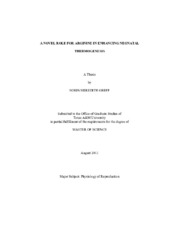| dc.description.abstract | Maintenance of body temperature is one of the first and most important physiological processes that must be initiated after birth. Failure to sustain homeothermy leads to hypothermia and death. Indeed, in sheep, 40% of non-predator lamb deaths are attributed to cold and cold-related causes. Brown adipose tissue (BAT) is an essential mediator of thermogenesis in many species and is responsible for 50% of the heat generated in the newborn lamb despite comprising only 2% of body weight. Previously, we found that maternal arginine supplementation increased fetal peri-renal BAT by 62%. This observation led us to test the hypothesis that increased the amount of fetal BAT will enhance neonatal thermogenesis at birth and thus combat the effects of cold stress. Thirty-one multiparous Suffolk ewes gestating singletons and twins were assigned to receive either intravenous injections of L-arginine (27 mg/kg bodyweight; n=17) or sterile saline (n=14) three times daily from Day 75 to Day 125 of gestation (term=147). Following parturition lambs were removed from their dams, placed in a thermoneutral environment, and fed artificial colostrum on a per body weight basis. At 4 hours of age, lambs were cold challenged at 0 degrees C for 2 hours. Rectal temperatures were recorded at 15 minute intervals. At 6 hours of age all singletons and one lamb of each twin pair was sacrificed. The remaining twin lamb was challenged again at 22 hours of age for an additional 2 hours prior to necropsy. Rectal temperature was greater for the duration of both cold challenges in lambs from arginine-treated ewes than lambs from saline-treated ewes (P<0.050). Interestingly, at time of necropsy, BAT weight did not differ (P>0.10) between treatments. UCP1 mRNA levels were not affected by treatment or age (P>0.10). However, TEK, PPARGC1A, NRF1, NRF2, PPARG, ADRB3, ARG2, RPS6KA1, EIF4EBP1, ODC1 were not affected by treatment (P>0.10) but were upregulated (P<0.05) by age; being greater at 24 hours of age versus 6 hours of age. Results indicate that maternal arginine treatment results in increased neonatal thermogenesis after birth. Although the underlying mechanisms remain to be elucidated, the data reported herein represent the first step in improving neonatal survival in response to cold. | en |


